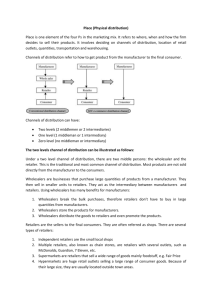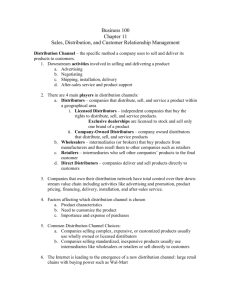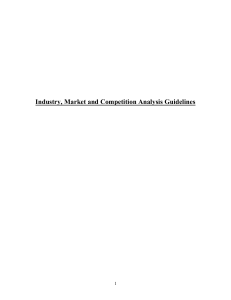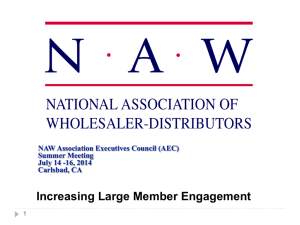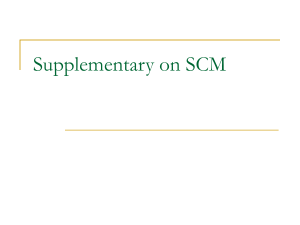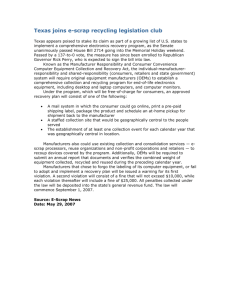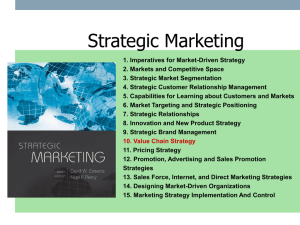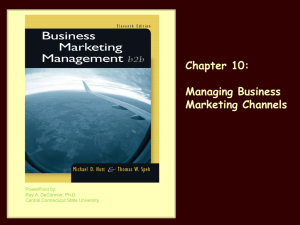CHAPTER 7- (marketing report)
advertisement
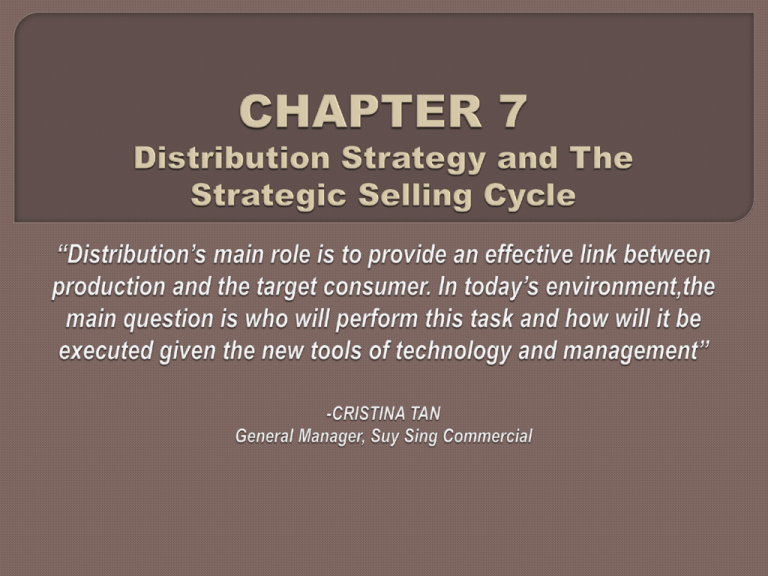
Both firms aim to make their products readily available consistent with their target customer’s purchasing pattern. Making products available needs a coherent distribution plan composed of the following 6 mix elements ; Having the proper types of outlet in a geographical area is important. Ex: Muslim do not eat pork so there is no need to prioritize coverage of pork luncheon meat in areas strongly dominated by Muslims. A product has placement when it is carried in a store. Placement objectives or having a right target number of outlets ensure customer’s utmost convenience. The right inventory level at the stores is critical . A firm may launch a new brand of shampoo or advertise a promotional campaign, which may result out-of-stock situations. The right shelf and offshelf locations plus adequate display space assure marketers a higher probability that consumers will choose their brand. The good spaces in the stores such as those at eye level are usually given to the leading brands, Having the right resale prices promotes healthy competition among dealers. Goodwill refers to the best relationship between a supplier and his channel members. Shows a comparative selling process of a firm targeting end users versus distribution channels. A. Selling to End Users B. Selling to Distrubution Channels Prospecting Routine Observation Pre-Approach Display Check Approach Warehouse Check Sales Probing Collection Presentation Presentation Handling Objections Handling Objections Demonstration Sell-Out Plan Closing Closing Distribution channels Marketing intermediaries make up a marketing or distribution channel. A distribution channel performs the work of moving products from manufacturers to final consumer or business users. A good distribution channel shortens the time, place, and possession gaps between the manufacturers and consumers. Distribution Channels : Manufacturer Distributors Jobbers Retailers End Users Distributors: Distributors are appointed to perform the distribution function for manufacturers in making their products available. They may sell to wholesalers or retailers or may even go directly to consumers. Wholesaling: Wholesaling are activities of persons or organizations that sell to those who buy for resale (like retailers) or business use (like industrial, institutional, and commercial users). Divisoria: There are several wholesalers located in divisoria and some retailers prefer to buy from them instead of directly from manufacturers because of their lenient credit policy. Jobbers: Jobbers are wholesalers who also provide warehousing space for manufacturers and distributors, thus enabling the latter to avoid a fixed cost. Is a sales operation where the ex-truck salesman carries stocks in his van or small truck, saturates a given territory regularly by selling his stocks on “cash” basis, and delivers the stocks immediately upon order. Some manufacturers or wholesalers/distributors are using the feeder model. Here instead of two-man team of the ex-truck sales-man and delivery helper saturating a territory with stocks in their van, a distributor salesman goes around by himself to take orders and relays these to a delivery team who will bring the orders to the retailers. Is an activity involving the sale of products or services directly to final consumers. An accelerated method to expand distribution is thru franchising. Franchising is a business relationship in which the franchisor (the owner of the business providing the product or service) assigns to independent people the right to market and distribute the franchisors goods or service, and to use the business name for the fixed period of time. Direct Selling: There are over two-dozen members of Direct Selling Association Of The Philippines (DSAP). Some members are: Amway (personal and home care) Avon (cosmetics and related products) Nu Skin (beauty and health care) Sunrider (food supplements) Tupperware (plastic wares) Waters (water purifiers and foot detox) Internet: E-business has been buzzword since the 1990's. No longer are companies limited to sell products through stores or through direct sales. Home Delivery: Home delivery offers a huge potential influenced by more women working, lack of household maids, traffic and parking problems, as well as the consumer psyche of rewarding themselves after a hard day's work. Diagnostic Distribution: We use the term diagnostic distribution to mean the proper matching of distribution channels to the selling process as in exhibit 7-3. Marketers, for instance, may combine different distribution channels to achieve desired sales, profit, market penetration and market shares objectives. Exhibit 7-3: Diagnostic Distribution Direct mail Prospecting (sales leads generation) Telemarketing Qualifying Sales Direct Selling Sales Probing Sales Presentation Handling Objectives Approach Retailing Closing Demonstration Dealers After Sales Service Firms may adapt or change their distribution methods depending on their needs during different scenarios. STRATEGIC ALLIANCES: Trade costumers and suppliers enter into a strategic alliance to attain some long-term objectives and mutually improve their position in the industry. Exhibit 7-4: Strategic alliance framework To Salesman as only link Team selling as an initial step to strategic alliance - Why compete? When you can collaborate? Competition can sometimes collaborate if the collaboration will result in the overall increase of satisfaction of each competitor’s customers as well as for cost-efficiency. - Marketers must be careful in choosing their distribution system, as each channel will produce different levels of costs and sales volume. In evaluating alternative distribution channels, the 3Cs of distribution must be considered: Cost- efficiency, Control, and Channel Modification. - It is important to estimate the long term impact of having one’s own sales force versus appointing a distributor. Once sales volume increases to an economic level, having one’s own sales force may be more cost-efficient assuming they can maintain at least the same volume and expense ratio. - As distributors are not the company’s employees, they may have different priorities. Profit may be their main objective while the firm’s objective may be market penetration and market shares. It is important that the objectives, priorities and expectations of the firm be communicated and agreed upon before principals are chosen and distributors are appointed. - The marketplace is ever changing. The flexibility to modify distribution may be needed. Other changes in the consumer purchasing pattern such as when the product matures, when new competition arises, and when innovative distribution emerges, must also considered. Product Type After Sales Service Company Resources Distribution Price USE MIDDLEMEN SELL DIRECT Simple Sophisticated Few Critical Weak Strong Low Control High Control Low High Marketing Channels usually describe forward movements of products from manufacturers to the ultimate consumers. However, it is possible that backward distribution will become trend as well as challenge with the increase popularity of green marketing as described in chapter 4E. Or A parallel distribution is a term used to describe UNATHORIZED importation and distribution of products bearing genuine brands across markets. The paraller distributor may or may not be an importer himself. If he is an importer, he is likely an importer resorting to smuggling products into Phillipines to avoid paying taxes . Smuggling comes in many form. -Outright smuggling -Technical smuggling Parallel distribution is destructive. This often result in price wars between the legitimate and the parallel distributor. Another problem posed by gray marketing is that goodwill established by the trademark owner is jeopardized because customers who purchase the goods in gray market do not get the same extended product. To stop PARALLEL DISTRIBUTION -always price the product reasonably or to have a goodtrade discount structure. -warn the customers about the unauthorized distribution where warranty may not be honored. -stop the supplying source of the parallel distibution. The european Community or EC became a single market in 1992. Its formation leaded to the expantion of the European Market base into US$15 trillion with 501 million consumer on 2008. US and canada had the similar free trade agreement in 1989. Mexico join US and Canada to form the NAFTA which officially start on jan 1, 1994. The ASEAN countries originay composed of Phillipines , Malasysia, Singapore, Thailand, Indonesia, and Brunei. Also have their similar version called ASEAN Free trade O AFTA (jan1992). AFTA is a single unified market ofover 592 million people worth US $ 1.49 trillion as of 2009. Under the original (CEPT) Common Effective Preferential Tariff agreement , tariffs for all manufactured products with at least 4o% ASEA component cont level, have progressively beenreduced to a maximum of 20% within five to eight years, and zero to five percent in subsequent seven year period. From production point of view, AFTA resulted to more and cheaper sources of raw materials as well as economies of scale. In the phillipines , tariff reduction was implementes gradually under EO470 and it started 1996. The Phillipine Government must FIRST and FOREMOST ensure political stability.The government must continuosly and consistently encourage local industries to upgrade production and research technologies to improve productivity and competitiveness. The Board of Investment or BOI must cut red tape and shorten the bureauracy to attract more foreign investment. Thank you for listening
